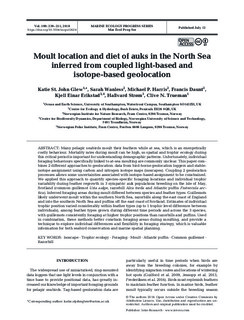Moult location and diet of auks in the North Sea inferred from coupled light-based and isotope-based geolocation
Glew, Katie St. John; Wanless, Sarah; Harris, Michael P.; Daunt, Francis; Erikstad, Kjell E; Strøm, Hallvard; Trueman, Clive N.
Journal article, Peer reviewed
Published version

Åpne
Permanent lenke
http://hdl.handle.net/11250/2558487Utgivelsesdato
2018Metadata
Vis full innførselSamlinger
- Publikasjoner fra CRIStin - NINA [2364]
- Scientific publications [1392]
Sammendrag
Many pelagic seabirds moult their feathers while at sea, which is an energetically
costly behaviour. Mortality rates during moult can be high, so spatial and trophic ecology during
this critical period is important for understanding demographic patterns. Unfortunately, individual
foraging behaviours specifically linked to at-sea moulting are commonly unclear. This paper combines
2 different approaches to geolocation: data from bird-borne geolocation loggers and stableisotope
assignment using carbon and nitrogen isotope maps (isoscapes). Coupling 2 geolocation
processes allows some uncertainties associated with isotope-based assignment to be constrained.
We applied this approach to quantify species-specific foraging locations and individual trophic
variability during feather regrowth in 3 sympatric auk populations breeding on the Isle of May,
Scotland (common guillemot Uria aalge, razorbill Alca torda and Atlantic puffin Fratercula arctica).
Inferred foraging areas during moult differed between species and feather types. Guillemots
likely underwent moult within the southern North Sea, razorbills along the east coast of England
and into the southern North Sea and puffins off the east coast of Scotland. Estimates of individual
trophic position varied considerably within feather types (up to 1 trophic level difference between
individuals), among feather types grown during different time periods and across the 3 species,
with guillemots consistently foraging at higher trophic positions than razorbills and puffins. Used
in combination, these methods better constrain foraging areas during moulting, and provide a
technique to explore individual differences and flexibility in foraging strategy, which is valuable
information for both seabird conservation and marine spatial planning.
